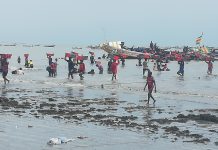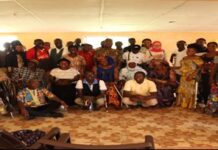Muhammad L. Darboe
For the past 70 years the economy of our country has been based on Agriculture, yet many Gambians, especially those living in rural Gambia continue to suffer in hunger and poverty. The pepper variety called ‘’Guana’’ today is imported from Senegal, when in fact it can be produced in our country. Banana is imported from Conakry, Onion from Holland, Beans from Senegal, even Carrot is imported from Senegal. Our staple food rice, is also imported at high cost to the nation. We spent D2.3 billion importing rice in 2016. During Tobaski, we import tens of thousands of sheep and cattle from Senegal and Mauritania. The backbone of our economy is agriculture, yet our food expenditure continues to be very high, consuming about 80% of the income of many rural families. The problem is not limited to cost of food, but also we have a problem of poor food quality, which evidently affects our health and increases our health spending. This situation persists despite the fact that about four hundred thousand Gambians are employed in the sector, which in itself is an indication of the serious policy problems in the sector.
So how did we get here? How did we break our backbone? Well to find answers to these questions we must revisit history. When agriculture is mentioned the first thing that comes to my mind and the minds of many Gambians, is groundnut. This is because the whole sector of agriculture was for the past 70 years, and is still centered on groundnuts. Our over reliance on groundnuts has made the whole sector and the economy vulnerable to external shocks and other risks.
In fact the increase in poverty in the country over the last three decades can be attributed to the decrease in the demand of groundnuts in the world market and strict measures followed by importing countries on aflatoxin levels. The previous two governments could not come up with the necessary policies to respond to the decrease in demand and aflatoxin levels, as a result of this the income of hundreds of thousands of farmers and families dropped to levels that our country has never seen before. Of course this situation forced many youths who would have been employed in agriculture to leave the rural settlements for the now congested urban settlements or embark on the suicide journey across the Mediterranean Sea.
The fundamental problems of ‘’akrikolcho’’ (as it is called in Kiang), which continue to derail our development can be summarized as follows;
- lack of enough equipment to engage in large scale farming,
- lack of processing facilities,
- lack of a solid diversification policy
- Insufficient affordable loan facilities for investment in agriculture
- And most importantly, the lack of a well communicated national agriculture policy to guide farmers
Agriculture of course had its heydays. This period was when little Gambia with a low literacy rate was able to process groundnuts into groundnut oil and cake. Then, SUBU DURANGO (peanut soup with meat) was a normal meal even in rural Gambia. In those days the annual income of many farmers was more than that of civil servants. Yes in those days the word hunger was not in our vocabulary. All these were only possible through robust government investment in the groundnut sector.
The Jawara government through the Gambia Cooperative Union (GCU) and later through the Gambia Produce Marketing Board (GPMB) directly managed the groundnut value chain. The government also laid the infrastructure needed for the transportation of groundnut from inland settlements to the coast. These included small inland ports along the River Gambia, and barges were supplied to transport groundnut and other goods along the river. Also groundnut selling points (Seckos) were set up across the country, where farmers sold their produce at subsidised prices. The government also provided farmers with fertilizers and seeds, and most importantly an Agriculture bank was set up to help farmers with low interest loans to buy machines and simple farm implements and inputs. So it should not come as a surprise that Agriculture experienced a boom during this period, which resulted in a noticeable improvement in living standard.
So how can we move on and solve the problems of the agriculture sector thereby providing steady incomes to hundreds of thousands of Gambians, improving our overall food security, and ultimately improving living standards of our countrymen. Solving problems of the sector should concern every single Gambian, because agriculture is the only sector that can lift hundreds of thousands of Gambians from poverty within a very short period. Also based on the level of education in the country it is the sector that we can easily tap into to grow our economy and improve lives.
The first thing we need to do in solving the problem with our back bone (agriculture), is to formulate and clearly communicate to our farmers, a solid and clear agriculture policy as part of our economic development policy, which can be used to drive our economy. Such a policy, must clearly spell out crops we need to produce, the animals we need to rear, the products we will process within the country, and the resources we will use for the production and processing of the selected crops or agricultural produce.
After we formulate the policies, before we do anything, we must set up an agriculture bank or create an agriculture fund from the national budget that will be used to implement our policies. Lack of low interest loans to fund agricultural ventures has affected the development of agriculture in our country. The current rates (15-17) at our local banks, cannot be utilized by our farmers to buy machinery and valuable farm inputs to increase their productivity. Agricultural investments require patient capital (capital invested for a medium or long term, generally 5 -10 years), that is lent at low interest. Setting up an agricultural bank or creating an agriculture fund will solve the problem of financing for agricultural ventures. Such a bank or fund can lend to farmers at lower interest rates (3-5%), for periods of 3-5 years. Interest payments made by farmers can be pumped back into the bank or fund to support more farmers. The government can go a step further and create a special advisory and mentor group under the Ministry of Agriculture, whose responsibility will be to guide and monitor the progress of the beneficiaries of the loans to minimize risk and ensure that the loans serve their purpose.
Am sure by now every single Gambian including those living in the hamlets of Kiang have heard the word DIVERSIFICATION from government officials, anytime they talk about agriculture. To put it simply, diversification means not putting all our eggs in one basket. In agriculture it means not putting all our resources, energy and hope on one product or crop, in our case, groundnuts. This makes sense, because in the event of a problem with a single product that we put all our hope on, the whole country suffers. We have seen this happen with groundnuts when the demand for it decreased partly due to aflatoxin infection. In order to protect ourselves from such risk we must grow different crops and plants, also rear sheep and cattle, so that if there is a problem with one the others can keep us on our feet until we solve the problem. Of course many crops and plants were suggested for this purpose, but i think the most important are Cashew, Banana, Rice, Onion, Potato, Sesame, Tomato, Bean, and Cotton. All these can be grown and some processed in The Gambia at a large scale if the right policies are adopted. Apart from Cashew, cotton, and Sesame the demand for all the others is very high within the country and 90% of the demand is met through imports. If we can grow all these in the country at least D4 billion will stay within the country and go to our farmers and more than this amount can be gained from exports.
To be continued.





















